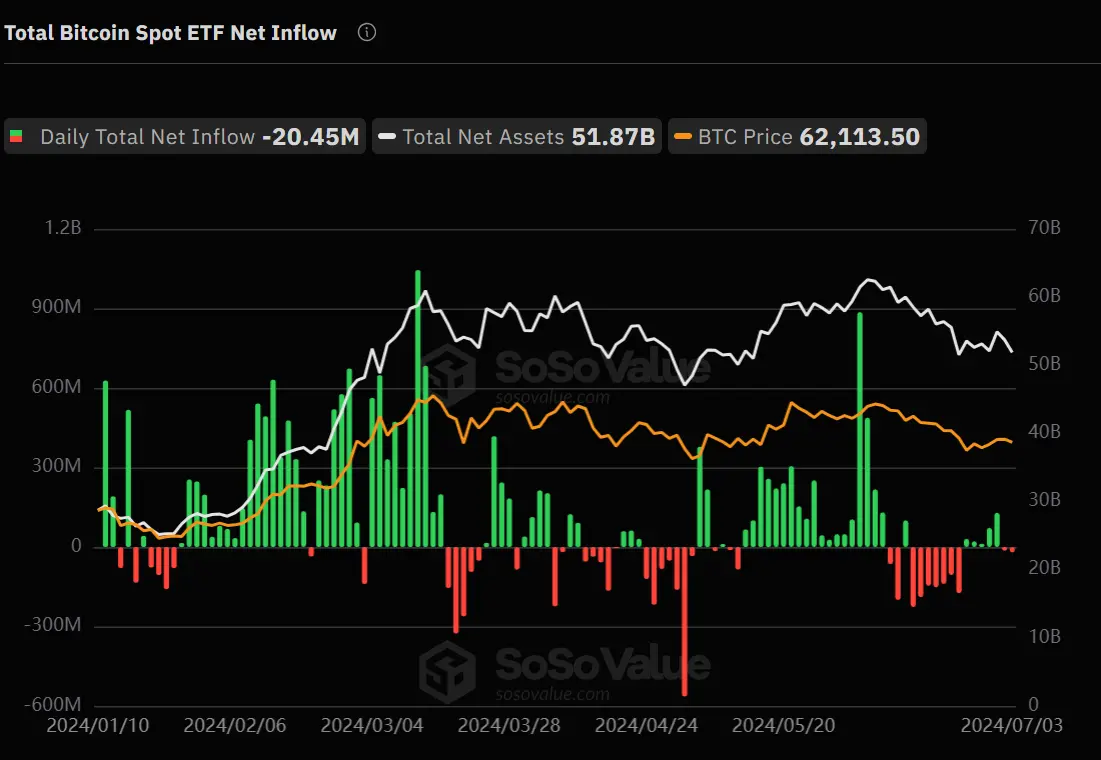Restoring the truth behind the market crash: The German government continues to sell off, and Mentougou adds fuel to the panic atmosphere
Author: 1912212.eth, Foresight News
After hovering above the 60,000 mark for several days, Bitcoin finally chose to "accelerate" downwards today, breaking through the 58,000 and 57,000 marks in succession after noon, with an intraday low of 56,952 USD, marking a nearly two-month low. Ethereum also fell from 3,300 USD to 3,126 USD, leading to a broad decline in the cryptocurrency market. In the Binance USDT market, there were fewer than ten non-stablecoin assets with positive gains in the past 24 hours, and ARB even hit a historical low of 0.71 USD during the day.
According to Coinglass data, a total of 207 million USD was liquidated in the past 12 hours, with 187 million USD from long positions.
What caused this deep correction in the "bull market" supported by a series of favorable factors such as "halving + ETF + elections"? Has the bull market really ended?
German Government Sells Approximately 10,000 BTC in Half a Month
At the beginning of this year, German police seized 50,000 Bitcoins, valued at 2.17 billion USD at the time, related to a case involving a copyright-infringing website operating since 2013, whose profits were later converted into Bitcoin. A statement indicated that one of the two suspects voluntarily transferred the Bitcoins to the Federal Criminal Police Office (BKA), and although no formal charges have been made against these individuals, investigations into subsequent money laundering activities are ongoing. At that time, the police statement also noted that a final decision regarding the use of the Bitcoins had not yet been made.
These Bitcoins finally began to be transferred and sold off in June this year, with a total of about 9,600 Bitcoins sold, leaving a current holding of 40,359 BTC.
On June 19, 6,500 Bitcoins were sold that day;
On June 25, at 5:20 PM, 400 Bitcoins were transferred to exchanges, and 500 Bitcoins to other addresses;
On June 26, at 3:50 PM, 750 Bitcoins were transferred out;
On July 1, at 4:26 PM, 400 Bitcoins were transferred to exchanges; subsequently, another 282.74 Bitcoins were transferred to multiple exchanges;
On July 2, at 7:20 PM, 361.877 Bitcoins were transferred to Flow Traders;

In today's transfers, the German government transferred 1,300 BTC to exchanges at 4:25 PM, and at 4:35 PM, transferred 1,700 BTC to an anonymous wallet address.
BTC finally fell below 57,000 USD around 5:15 PM today, with a low of 56,952 USD.
Large Compensation from Mt. Gox Begins Small Transfer Testing
The compensation issue from Mt. Gox has captured the market's attention, with up to 142,000 BTC and 143,000 BCH in selling pressure, which caused market panic on June 24, driving BTC prices down to around 60,000 USD. However, since the actual distribution of transfers had not begun at that time, the 60,000 USD mark was maintained. According to documents disclosed earlier on the official website, the Mt. Gox trustee stated that the repayment work for BTC and BCH would begin in early July.

As of July 4, according to the latest data from the Arkham platform, Mt. Gox conducted test transfers today at 12 PM. The market had already entered a downward trend around 9 AM today; although the selling pressure was not from Mt. Gox, it still cast a shadow over market confidence, as significant selling pressure looms ahead, and no one wishes to stand under a precarious wall.
BTC Spot ETF Experiences First Net Outflow After Five Days of Inflows
The Bitcoin spot ETF serves as an important data point for buying and selling, allowing observation of market buying and selling strength. However, the data is not optimistic; according to SoSoValue, the total net outflow on July 3 reached 20.4495 million USD, marking the first net outflow after five days of inflows.

When we extend the timeline, the above chart clearly shows that when the net inflow of Bitcoin spot ETFs is high, Bitcoin prices tend to rise. Conversely, when the net outflow increases, Bitcoin prices clearly decline. In May, the continuous net inflow of funds supported the rise in Bitcoin prices, but entering June, the total net outflow accelerated significantly, with funds flowing out substantially.
What’s Next?
QCP Capital, in its latest market analysis, stated that BTC broke below the 60,000 USD support level under heavy selling pressure, with signs of capitulation among BTC miners, which historically often indicates a price bottom. The last comparable drop in hash rate occurred in 2022 when Bitcoin traded at 17,000 USD. Furthermore, despite severe sell-offs in the cryptocurrency market, the options market remains optimistic, especially with a strong bias towards ETH call options expiring in September and December.
QCP Capital believes that considering the recent selling pressure from Bitcoin, as well as factors driven by Mt. Gox, miners, and government regulation, ETH may see a stronger rebound due to the upcoming submission of the Ethereum spot S-1 filing.
On the other hand, Andrew Kang, co-founder and partner of Mechanism Capital, appears more pessimistic.
He stated that most market participants have not realized the seriousness of the potential decline in Bitcoin's four-month volatility range. The closest comparable situation we can find is the range from May 2021, when Bitcoin and altcoins also experienced a parabolic rise. The over 50 billion USD in cryptocurrency leverage is also close to historical highs (excluding CME), but in this case, our range time is longer (18 weeks vs. 13 weeks), and there has not yet been extreme liquidation, whereas we experienced several during the bull market from 2020 to 2021.
He also mentioned that the initially estimated low point of 50,000 USD might be too conservative, and we could see a more extreme correction down to the 40,000 USD range. Such a correction could cause significant damage to the market and may require several months of consolidation/downward trends (recovery period) before a potential upward trend reversal could occur.












